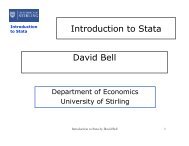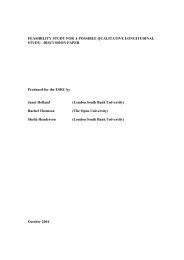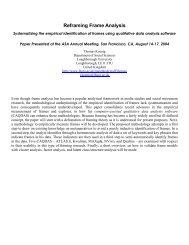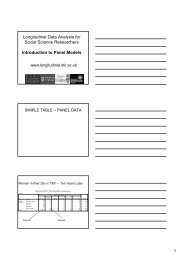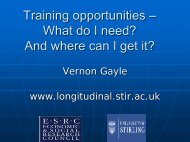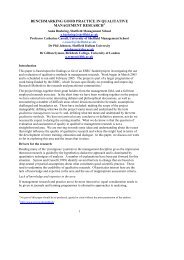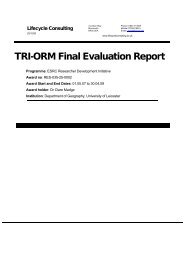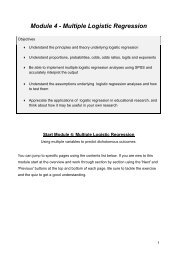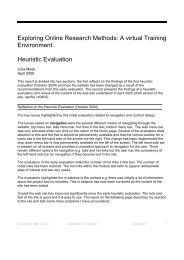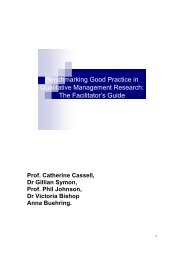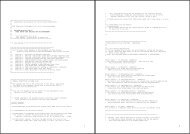Using NVIVO in relation to the establishment of causal configuration ...
Using NVIVO in relation to the establishment of causal configuration ...
Using NVIVO in relation to the establishment of causal configuration ...
You also want an ePaper? Increase the reach of your titles
YUMPU automatically turns print PDFs into web optimized ePapers that Google loves.
<strong>Us<strong>in</strong>g</strong> <strong>NVIVO</strong> <strong>in</strong> <strong>relation</strong> <strong>to</strong> <strong>the</strong> <strong>establishment</strong> <strong>of</strong> <strong>causal</strong><br />
<strong>configuration</strong>s.<br />
David Byrne<br />
david.byrne@durham.ac.uk<br />
Please cite as:<br />
Byrne D. 2005 <strong>Us<strong>in</strong>g</strong> <strong>NVIVO</strong> <strong>in</strong> <strong>relation</strong> <strong>to</strong> <strong>the</strong> <strong>establishment</strong> <strong>of</strong> <strong>causal</strong> <strong>configuration</strong>s.<br />
Paper presented as part <strong>of</strong> <strong>the</strong> Focus<strong>in</strong>g on <strong>the</strong> Case Workshop Series, December, 2004.<br />
1. The first th<strong>in</strong>g <strong>to</strong> appreciate is that we are here concerned with understand<strong>in</strong>g<br />
which is <strong>to</strong> do with <strong>the</strong> <strong>establishment</strong> <strong>of</strong> cause. Our methods do <strong>in</strong>volve<br />
INTERPRETATION but <strong>in</strong> a ra<strong>the</strong>r different mode from that which Vulliamy has<br />
described <strong>in</strong> a recent paper:<br />
‘… ethnographers, <strong>in</strong>fluenced by traditions such as poststructuralism,<br />
postmodernism, fem<strong>in</strong>ism and postcolonialism, that stress multi-perspectivism<br />
and <strong>the</strong> complex <strong>in</strong>ter<strong>relation</strong>ships between language, knowledge and power,<br />
have been critical <strong>of</strong> code and retrieval s<strong>of</strong>tware packages and <strong>the</strong> grounded<br />
<strong>the</strong>ory approach underp<strong>in</strong>n<strong>in</strong>g <strong>the</strong>m. … Instead <strong>the</strong>y have experimented with<br />
<strong>the</strong> textual presentation <strong>of</strong> data through hypertext and hypermedia programmes,<br />
where <strong>the</strong> reader can choose different pathways through both selections <strong>of</strong><br />
qualitative data – such as field notes, documents or <strong>in</strong>terview transcripts – and<br />
<strong>the</strong> author’s discourse analysis <strong>of</strong> <strong>the</strong>m. They argue that hypertext s<strong>of</strong>tware<br />
helps preserve <strong>the</strong> complexity and multi-mean<strong>in</strong>gs <strong>of</strong> social life by enabl<strong>in</strong>g a<br />
presentation <strong>of</strong> text that is non-sequential, unlike code and retrieval packages<br />
which privilege <strong>the</strong> sole l<strong>in</strong>ear account <strong>of</strong> <strong>the</strong> researcher.’ (2004 270)<br />
If <strong>the</strong>re is a cont<strong>in</strong>uum which runs thus <strong>in</strong> qualitative work:<br />
Post-Interpretation – <strong>the</strong>matic grounded <strong>the</strong>ory – case centred grounded <strong>the</strong>ory – data construction content analysis<br />
Then <strong>the</strong> position described here falls somewhere between case centred grounded<br />
<strong>the</strong>ory and data construction. Those <strong>of</strong> you who have used <strong>NVIVO</strong> will know that<br />
<strong>the</strong> traditional emphasis has been on review<strong>in</strong>g <strong>the</strong> data <strong>in</strong> an <strong>in</strong>terpretive fashion<br />
<strong>in</strong> order <strong>to</strong> establish NODES <strong>in</strong> TREES. I have <strong>in</strong>serted below two slides from a<br />
presentation given <strong>to</strong> Masters’ students which was about mix<strong>in</strong>g quantitative and<br />
qualitative methods. They def<strong>in</strong>e <strong>the</strong> actual general approach <strong>of</strong> qualitative<br />
researchers as concerned with a <strong>the</strong>orization which is holistic and not reductionist.<br />
AND YET:<br />
1
What k<strong>in</strong>d <strong>of</strong> explanations do qualitative researchers <strong>of</strong>fer <strong>in</strong> terms <strong>of</strong><br />
visualizations? They generally develop models – <strong>NVIVO</strong> has a modell<strong>in</strong>g <strong>to</strong>ol –<br />
which look remarkably like <strong>the</strong> variable based models <strong>of</strong> traditional quantitative<br />
<strong>causal</strong> modell<strong>in</strong>g. Sure, <strong>the</strong>y don’t have numeric values attached and <strong>the</strong> format is<br />
looser but <strong>the</strong>re is a real belief <strong>in</strong> th<strong>in</strong>gs which matter outwith <strong>the</strong> cases<br />
<strong>the</strong>mselves. This is not adher<strong>in</strong>g <strong>to</strong> <strong>the</strong> phenomenological project <strong>of</strong> ‘GOING<br />
BACK TO THE THINGS THEMSELVES’. In o<strong>the</strong>r words it rema<strong>in</strong>s analytical.<br />
Interpretivism - <strong>of</strong>ten associated<br />
with qualitative research:<br />
• Reality is socially constructed through collective<br />
def<strong>in</strong>itions <strong>of</strong> phenomena.<br />
• The goal <strong>of</strong> research is <strong>to</strong> <strong>in</strong>terpret phenomena from<br />
multiple perspectives.<br />
• Importance placed on multiple mean<strong>in</strong>gs <strong>of</strong> <strong>in</strong>dividual<br />
experiences<br />
• Mean<strong>in</strong>gs socially and his<strong>to</strong>rically constructed, with an<br />
<strong>in</strong>tent <strong>of</strong> develop<strong>in</strong>g a <strong>the</strong>ory or pattern.<br />
• Ethnographic methods (e.g. participant observation) and<br />
<strong>in</strong>terviews are best because <strong>the</strong>y provide <strong>the</strong> basis for<br />
shar<strong>in</strong>g <strong>in</strong>terpretations.<br />
• Immersion is <strong>the</strong> ideal state dur<strong>in</strong>g <strong>the</strong> research process.<br />
9<br />
2
Inductive Logic –<br />
associated with <strong>the</strong> Qualitative<br />
Approach<br />
Generalizations and/or Theories, Past Experiences and Literature<br />
Researcher Looks for Broad Patterns, Generalizations, or<br />
Theories from Themes or Categories<br />
Researcher Analyzes Data <strong>to</strong> Form Themes or Categories<br />
Researcher Asks Open-Ended Questions <strong>of</strong> Participants<br />
and/or Records Fieldnotes<br />
Researcher Ga<strong>the</strong>rs Information (e.g. <strong>in</strong>terviews, observations)<br />
(Creswell 2003)<br />
10<br />
3
Traditional Use <strong>of</strong> <strong>NVIVO</strong><br />
What most people do with <strong>NVIVO</strong> is work through <strong>the</strong> texts <strong>the</strong>y have and code blocks<br />
<strong>of</strong> text <strong>to</strong> one or more NODES or sub-nodes represent<strong>in</strong>g <strong>the</strong>mes. The purpose is largely<br />
<strong>to</strong> retrieve illustrative material for a textually based argument. Occasionally but not that<br />
<strong>of</strong>ten <strong>the</strong> model build<strong>in</strong>g facility is used <strong>to</strong> construct a visualization <strong>of</strong> <strong>the</strong> <strong>relation</strong>ship<br />
among <strong>the</strong>mes. THERE IS NOTHING WRONG WITH THIS. However, a case based<br />
approach is different. It beg<strong>in</strong>s with attributes. Let me quote <strong>the</strong> <strong>NVIVO</strong> help facility on<br />
this <strong>to</strong>pic:<br />
Attributes<br />
Attributes are <strong>in</strong>formation about <strong>the</strong> people, sites or o<strong>the</strong>r items represented by <strong>the</strong><br />
documents or nodes <strong>in</strong> your project . For example, a document may be an <strong>in</strong>terview with<br />
a person whose age and gender you know. A person may be discussed <strong>in</strong> many<br />
documents. Code all <strong>the</strong> documents at a case node for <strong>the</strong> person, and create <strong>the</strong> attributes<br />
‘Age’ and ‘Gender’ for <strong>the</strong> case node. As more material comes <strong>in</strong>, code it <strong>to</strong> <strong>the</strong> case<br />
node, and <strong>the</strong> attributes are au<strong>to</strong>matically applied.<br />
You may already have this <strong>in</strong>formation, or you may ga<strong>the</strong>r and record it as your project<br />
progresses. Record<strong>in</strong>g attributes will allow you <strong>to</strong> search your data more effectively. For<br />
example, you can use attributes <strong>to</strong> see whe<strong>the</strong>r men and women (or Catholics and<br />
Protestants; or primary school and high school students) hold different views on a <strong>to</strong>pic.<br />
If you have a table <strong>of</strong> <strong>in</strong>formation about <strong>the</strong> people, sites or o<strong>the</strong>r items represented by<br />
your documents or nodes, you can import that and create <strong>the</strong> attributes and values needed<br />
<strong>to</strong> s<strong>to</strong>re that <strong>in</strong>formation. See <strong>the</strong> Violence Prevention Stage 1 tu<strong>to</strong>rial for an example <strong>of</strong><br />
table import.<br />
Attributes and <strong>the</strong>ir <strong>in</strong>itial values can be created before <strong>the</strong>y are assigned <strong>to</strong> any items.<br />
They can be changed at any time. For example, you might start with <strong>the</strong> values “Rural”<br />
and “Urban” for <strong>the</strong> attribute ‘Location’, <strong>the</strong>n when you realize <strong>the</strong> significance <strong>of</strong> semiurban<br />
locations and different rural sett<strong>in</strong>gs you might add fur<strong>the</strong>r values and assign <strong>the</strong>m<br />
<strong>to</strong> items that are considered <strong>to</strong> suit those values.<br />
You can also delete an attribute value or replace all <strong>of</strong> its occurrences with a new or<br />
exist<strong>in</strong>g value. To give a document or node <strong>the</strong> attributes <strong>of</strong> some conceptually related<br />
node, you can copy <strong>the</strong> attributes <strong>of</strong> ano<strong>the</strong>r item.<br />
Attributes can be imported from any s<strong>of</strong>tware that creates tables – SPSS, Excel, or simply<br />
your word processor. See Import<strong>in</strong>g Attributes for full details.<br />
4
Export<strong>in</strong>g Attributes<br />
From <strong>the</strong> Attribute Explorer :<br />
Select File > Export.<br />
If you wish, type a new name for <strong>the</strong> exported table.<br />
Click Save.<br />
NVivo creates a tab-separated table conta<strong>in</strong><strong>in</strong>g <strong>the</strong> attribute values. You can open <strong>the</strong> file<br />
<strong>in</strong> a spreadsheet or statistics program <strong>to</strong> work with your data. The latest version creates an<br />
SPSS dat table which with some care – see below – can be entered <strong>in</strong><strong>to</strong> SPSS.<br />
A Different View <strong>of</strong> Attributes<br />
Note that attributes are unders<strong>to</strong>od <strong>in</strong> a different way <strong>in</strong> <strong>the</strong> above passage from variables.<br />
When we measure variables we go <strong>to</strong> <strong>the</strong> world with an operationalized mechanism for<br />
construct<strong>in</strong>g data. It is perfectly true that with ‘open-ended’ questions we do actually see<br />
what <strong>the</strong> world is tell<strong>in</strong>g us before we construct <strong>the</strong> cod<strong>in</strong>g frame through which we<br />
constra<strong>in</strong> text – <strong>in</strong>formation held <strong>in</strong> <strong>the</strong> natural language <strong>of</strong> everyday life as Bateson<br />
(1984) called it –<strong>in</strong><strong>to</strong> data expressed as numbers. However, we do not generally<br />
recognize what a revolutionary process this is. We actually let people tell us about <strong>the</strong><br />
world before we construct our measurements and we do so on <strong>the</strong> basis <strong>of</strong> what <strong>the</strong>y have<br />
said.<br />
I don’t th<strong>in</strong>k <strong>the</strong> crea<strong>to</strong>rs <strong>of</strong> <strong>NVIVO</strong> actually appreciated <strong>the</strong> revolutionary character <strong>of</strong><br />
attributes, although I may well be absolutely wrong. Attributes are measures which<br />
emerge from our engagement with textual and o<strong>the</strong>r representations <strong>of</strong> <strong>the</strong> world. Note<br />
what NIVO says above:<br />
Attributes are <strong>in</strong>formation about <strong>the</strong> people, sites or o<strong>the</strong>r items represented by <strong>the</strong><br />
documents or nodes <strong>in</strong> your project .<br />
In o<strong>the</strong>r words attributes can be constructed as <strong>in</strong>formation about cases, but this<br />
<strong>in</strong>formation can be developed through a grounded and cont<strong>in</strong>u<strong>in</strong>g <strong>in</strong>terpretive<br />
engagement with actual <strong>in</strong>formation about <strong>the</strong> world expressed as text and images.<br />
Our Example<br />
We are go<strong>in</strong>g <strong>to</strong> work with case studies – <strong>in</strong> <strong>the</strong> form <strong>of</strong> publicly available OFSTED<br />
reports for a set <strong>of</strong> secondary schools - <strong>in</strong> this case five ra<strong>the</strong>r arbitrarily selected. I have<br />
started construct<strong>in</strong>g attribute sets for <strong>the</strong>se five, although even for a small N fsQCA we<br />
would need more examples. You will have access <strong>to</strong> <strong>the</strong> <strong>NVIVO</strong> project and can engage<br />
with attribute construction and export. Here <strong>the</strong> text does <strong>in</strong>clude numbers, although <strong>the</strong><br />
metrics are not consistent from case <strong>to</strong> case. We will beg<strong>in</strong> with export<strong>in</strong>g text as nom<strong>in</strong>al<br />
variables which we can <strong>the</strong>n nom<strong>in</strong>alize as numbers, ‘fuzzy’ and ord<strong>in</strong>alize as ranks. So<br />
5
we are measur<strong>in</strong>g but our measurement system is emergent <strong>in</strong> terms both <strong>of</strong> <strong>the</strong> th<strong>in</strong>gs we<br />
measure and <strong>the</strong> actual range <strong>of</strong> values we specify for <strong>the</strong> measurement.<br />
The OFSTED case studies with URLs are :<br />
New College School Leicester: http://www.<strong>of</strong>sted.gov.uk/reports/131/131945.htm<br />
Joseph Swan School Gateshead http://www.<strong>of</strong>sted.gov.uk/reports/131/131048.pdf<br />
Walker Technology College Newcastle http://www.<strong>of</strong>sted.gov.uk/reports/108/108525.pdf<br />
St Paul’s Leicester http://www.<strong>of</strong>sted.gov.uk/reports/120/120307.pdf<br />
The Hermitage School, Chester-le-Street<br />
http://www.<strong>of</strong>sted.gov.uk/reports/114/114290.pdf<br />
S<strong>in</strong>ce we might have multiple documents relat<strong>in</strong>g <strong>to</strong> any case we should establish each<br />
case as a case node <strong>in</strong> <strong>NVIVO</strong>. The attribute table will <strong>the</strong>n be a table <strong>of</strong> attributes for<br />
each case node.<br />
Ano<strong>the</strong>r aspect <strong>of</strong> <strong>NVIVO</strong> which can be useful <strong>to</strong> us is SETS. This is simply a way <strong>of</strong><br />
organiz<strong>in</strong>g th<strong>in</strong>gs <strong>in</strong><strong>to</strong> categories. In general <strong>in</strong> <strong>the</strong> creation <strong>of</strong> attributes we should have a<br />
unique set <strong>of</strong> attributes for each case node but we may well want <strong>to</strong> organize documents<br />
associated with a particular case <strong>in</strong><strong>to</strong> sets.<br />
Some Tips on Export<strong>in</strong>g Attributes for use <strong>in</strong> QCA<br />
The easiest way <strong>to</strong> do this is <strong>to</strong> save <strong>the</strong> attributes as an SPSS dat file. Make sure that <strong>the</strong><br />
attributes are arranged so that attributes are columns and rows are cases.<br />
In import<strong>in</strong>g <strong>to</strong> SPSS:<br />
1. At step one specify that <strong>the</strong> imported file does not follow a predeterm<strong>in</strong>ed format.<br />
2. At step two click <strong>to</strong> <strong>in</strong>dicate both that <strong>the</strong> file is delimited and that variable names<br />
are <strong>in</strong>cluded at <strong>the</strong> <strong>to</strong>p <strong>of</strong> <strong>the</strong> file.<br />
3. At step three just press next.<br />
4. At step four make sure that only tab is clicked as a delimiter. Do not have space<br />
clicked.<br />
5. At step five you will need <strong>to</strong> highlight each variable and ensure that it is recorded<br />
as <strong>the</strong> appropriate type – str<strong>in</strong>g or numeric – and that is has enough characters<br />
allocated for its values.<br />
6. At step six click f<strong>in</strong>ish.<br />
6
You can skip <strong>the</strong> stage <strong>of</strong> import<strong>in</strong>g <strong>to</strong> SPSS and just read straight <strong>in</strong><strong>to</strong> fsQCA or<br />
Tosmana but it is <strong>of</strong>ten convenient <strong>to</strong> use SPSS’s larger reper<strong>to</strong>ire <strong>of</strong> data management<br />
<strong>to</strong>ols for recod<strong>in</strong>g, b<strong>in</strong>ariz<strong>in</strong>g, fuzzy<strong>in</strong>g etc.<br />
Be careful about variable names when import<strong>in</strong>g <strong>in</strong><strong>to</strong> Tosmana. There is a length limit so<br />
us<strong>in</strong>g ‘Quality <strong>of</strong> ‘ <strong>to</strong> describe quality <strong>of</strong> three different aspects will give Tosmana <strong>the</strong><br />
heeby-jeebies and it won’t do it.<br />
7



